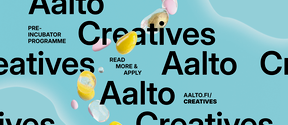Will the news anchor of the future be an artificial person?
ITP students developed a concept of an artificial person for Yle.

In the Summer of 2020, ITP 2020’s Strategic and Experience Design (SED) track’s team Desert Rose, composed of students Axa Lares, Linnea Anttila, Ly Tran, Pyry Kanerva and Ya-Yu Tseng, was tasked with applying design thinking to the City of Espoo’s Enterprise Architecture (EA). EA refers to a set of documentation describing how an enterprise's business processes, organizational units, data and systems work as a whole, and then planning and governing changes to improve the coherence and flexibility of the enterprise.
Linnea Anttila, ITP student 2020We sought to combine design with the city’s enterprise architecture so as to improve the interoperability at strategical levels.
The members of Desert Rose team describe the project topic in better detail: ‘We were to familiarize ourselves with the City of Espoo’s EA and propose a series of recommendations for change management’, explains Anttila. Lares describes the aim of the project as helping Espoo to ‘make the city more resilient towards future changes, so that they can best serve the needs of citizens and other stakeholders’.
To support the development of the project, ITP comprises a series of lecture courses. In the SED track, the students get to learn about human centricity, and are encouraged to bring design into their approach. The students learn to think of design as an approach with methods and tools for gaining an understanding of what the customer needs and developing solutions in an iterative manner, using multidisciplinary teams and often including the customer in the process. This involvement of the customer stems from design’s human-centricity, according to which better results are achieved by involving the human perspective in all steps of the problem-solving process.
Design as method means that the project development follows design thinking and uses design tools. Rather than relying solely on desk research, the team put their hands on the dirt to understand the problem through field research. ‘We did seven interviews and then we had a plan to have a workshop’, says Anttila. Lares clarifies: ‘The interviews mostly focused on the horizontal and vertical communication, management, processes and tools and management in the city’. Particularly fruitful was the design workshop the team organized. ‘We had the idea to hold a workshop right at the beginning’, Tran recalls and continues how ‘the workshop was a way of creating an environment to have people from different parts of the City of Espoo come together’. Tseng adds: 'We used many activities, such as the break up letter or clustering, which we had structured beforehand. We sought to involve the participants through different activities.'
Ly Tran, ITP student 2020The workshop was a way of creating an environment to have people from different parts of the City of Espoo come together.
Through their research, the team found that investing in the City of Espoo’s design maturity (the extent to which an organization incorporates design practices in their overall system) would be key in future-proofing it. ‘We sought to combine design with the city’s enterprise architecture so as to improve the interoperability at strategic levels’, explains Anttila and continues that ‘EA is not very human-centric, and design could solve the complicated problems caused by EA. To try and understand what the customer needs, we looked at the City of Espoo’s strategic level EA, but we didn’t find that much information on how EA actually reaches the citizens.’
At the end of the program, the project team delivered a design maturity roadmap to the client to guide the City of Espoo through a leap in its design maturity, together with a communication plan to assist EA stakeholders in understanding the need for EA development.
The City of Espoo is no stranger to the importance of design. The municipality has had innovation and design as central elements of its strategy, and has garnered international recognition for its efforts. With its thriving business community and highly educated and digital-savvy population, the city is known as a hub of know-how, research and development.
ITP is a minor program organized by the School of Business. A central aspect to the program is itschallenge-based approach to learning, and it has for 25 years been a pioneer in such pedagogical practices, both within Aalto and internationally. The program seeks to bring together business, design and technology, and is divided into three tracks, each with a different focus.
The Strategy and Experience Design (SED) track puts a bigger emphasis on design as a problem-solving method. This means that design is not understood solely as a visual tool, implemented in the final stages of a process, but rather as a way of thinking and working.

ITP students developed a concept of an artificial person for Yle.

An ITP and Technology Industries of Finland collaboration studied how a Digital Product Passport could increase circular economy.

In ITP 2020, multidisciplinary student teams successfully completed nearly 20 digital business projects in collaboration with public and private organizations.

Information Technology Program (ITP), Aalto University’s summer minor program, ran its courses and business projects in a hybrid model during the summer while taking care of everyone’s safety.

Aalto University Information Technology Program (ITP) is a minor program (24 ECTS) that is completed during the summer period (3 months). It brings students together from diverse backgrounds and all around the world to solve digital business problems.

ITP collaborates with companies and organizations with digital business challenges solved by student teams.


